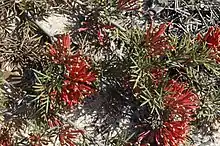Grevillea huegelii
Grevillea huegelii, commonly known as comb spider-flower or comb grevillea,[2] is a species of flowering plant in the family Proteaceae and is endemic to southern continental Australia. It is an erect to low-lying shrub with divided leaves with mostly three to eleven sharply-pointed linear lobes, and clusters of red to pink flowers that are silky-hairy on the outside.
| Grevillea huegelii | |
|---|---|
 | |
| Scientific classification | |
| Kingdom: | Plantae |
| Clade: | Tracheophytes |
| Clade: | Angiosperms |
| Clade: | Eudicots |
| Order: | Proteales |
| Family: | Proteaceae |
| Genus: | Grevillea |
| Species: | G. huegelii |
| Binomial name | |
| Grevillea huegelii | |
| Synonyms[1] | |
| |

Description
Grevillea huegelii is an erect to low-lying or straggling shrub that typically grows up to 3 m (9.8 ft) high and 4 m (13 ft) wide. Its leaves are 10–60 mm (0.39–2.36 in) long and 7–65 mm (0.28–2.56 in) wide in outline with mostly three to eleven sharply-pointed, linear lobes 5–40 mm (0.20–1.57 in) long and 0.7–2.2 mm (0.028–0.087 in) wide, the edges rolled under obscuring most of the lower surface. The flowers are arranged in loose clusters on a silky-hairy rachis usually 5–14 mm (0.20–0.55 in) long, the perianth straight, red to pink and silky-hairy on the outside, the pistil 19–29 mm (0.75–1.14 in) long. Flowering occurs in most months with a peak from July to December, and the fruit is a glabrous follicle 10–12 mm (0.39–0.47 in) long.[2][3][4][5][6]
Taxonomy
Grevillea huegelii was first formally described in 1845 by Carl Meissner in Johann Georg Christian Lehmann's Plantae Preissianae from specimens collected near the Avon River, near York in 1839.[7][8] The specific epithet (huegelii) honours Charles von Hügel.[9]
Distribution and habitat
Comb spider-flower grows in a variety of habitats, including mallee woodland and heath and has a disjunct distribution in southern continental Australia. In Western Australia it is widespread from Moora to Borden and east to Cundeelee and Balladonia. It is also widespread in the southern half of South Australia, the north-west of Victoria and in western New South Wales.[2][3][4][5][6]
References
- "Grevillea huegelii". Australian Plant Census. Retrieved 19 May 2022.
- "Grevillea huegelii". State Herbarium of South Australia. Retrieved 19 May 2022.
- "Grevillea huegelii". Australian Biological Resources Study, Department of Agriculture, Water and the Environment: Canberra. Retrieved 19 May 2022.
- "Grevillea huegelii". FloraBase. Western Australian Government Department of Biodiversity, Conservation and Attractions.
- Makinson, Robert O. "Grevillea huegelii". Royal Botanic Garden Sydney. Retrieved 19 May 2022.
- Makinson, Robert O. "Grevillea huegelii". Royal Botanic Gardens Victoria. Retrieved 19 May 2022.
- "Grevillea huegelii". APNI. Retrieved 19 May 2022.
- Meissner, Carl; Lehmann, Johann G.C. (1845). Plantae Preissianae. Vol. 1. Hamburg. p. 543. Retrieved 19 May 2022.
- Sharr, Francis Aubi; George, Alex (2019). Western Australian Plant Names and Their Meanings (3rd ed.). Kardinya, WA: Four Gables Press. p. 219. ISBN 9780958034180.